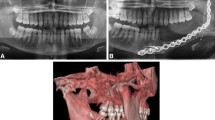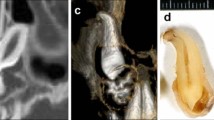Abstract
Aim:
We report a case of calcifying cystic odontogenic tumor affecting maxilla in a 48 year old male patient presented with painless extensive intraoral swelling with unilocular radiolucency and marked resorption of roots on radiographs.
Summary:
Calcifying cystic odontogenic tumor (CCOT) is rare developmental odontogenic pathology. The first description of lesion was given in 1962. Various terminologies and classifications have been proposed for description of the lesion. CCOT has extraosseous and intraosseous variants. Clinically it usually presents as a slow growing painless swelling of maxilla or mandible. It commonly involves anterior region of jaws, shows no gender predilection. Radiographically the lesion has variable appearance. The most common presentation is a well defined unilocular radiolucency associated with irregular calcification. Presence of ghost cells with proliferative odontogenic epithelium is the characteristic feature of the lesion. Surgical enucleation is the treatment of choice.
Similar content being viewed by others
Avoid common mistakes on your manuscript.
Introduction
Calcifying cystic odontogenic tumor first described by Gorlin in 1962, is a rare lesion representing 2% of all odontogenic pathological changes in the jaw. WHO in 2005, designated it as a tumor and renamed it as “Calcifying cystic odontogenic tumor” (CCOT).
CCOT is believed to be developmental in origin, derived from odontogenic epithelial remnants. It can occur at any age, with maximum incidence in the 2nd decade of life. It can occur centrally or peripherally, usually presenting as a painless swelling of jaw, equally affecting maxilla and mandible and more commonly involving anterior region than posterior. Prognosis of the lesion is good with few cases of recurrence have been reported following surgical enucleation.
Case
A 48 year old male patient presented with a swelling on the left side of his face for the past 1 week. On extraoral examination patient had noticeable facial asymmetry with a diffuse, firm, mildly tender swelling on left middle third of the face. Intraorally, obliteration of buccal vestibule was seen in maxillary left posterior region and palatally the swelling was extending to the midline (Figure 1). On palpation, swelling was firm with slightly fluctuant area in the centre; there was expansion of cortical plates. Teeth in relation 23, 24, 25, 26 to swelling were mobile and gingival recession was present with respect to 23. Electric pulp testing revealed no response in relation to 22, 23 and delayed response in 24, 25, 26, 27. A provisional diagnosis of periapical cyst was made.
Panoramic radiograph revealed a unilocular radiolucency with well defined borders with respect to 23, 24, 25, 26, 27 and root resorption with respect to 24, 26 (Figure 2). Intraoral periapical radiographs with respect to 22, 23, 24, 25, 26 revealed unilocular radiolucency with well defined borders in relation to apices of these teeth and marked root resorption in relation to 23, 24, 26 (Figure 3, 4). Lateral maxillary occlusal radiograph revealed multilocular radiolucency on palatal and buccal aspect with respect to 23, 24, 25, 26 and expansion and thinning of cortical plates Figure (5). Paranasal sinus view revealed a dome sh0aped radiopacity in left maxillary sinus Figure (6).
Around 4 ml of blood tinged fluid was aspirated from the swelling which revealed inflammatory cells in a hemorrhagic background.
Incisional biopsy revealed cystic lumen lined by non keratinized stratified epithelium which exhibited palisading of basal cells with reversal of polarity. Overlying cell layers showed stellate reticulum like morphology. Aggregates of ghost cells were seen in epithelial lining. Capsular stroma showed the presence of dentinoid.
Based on these findings a final diagnosis of calcifying cystic odontogenic tumor was given. The lesion was surgically enucleated along with extraction of the teeth involved. No recurrence of the lesion was noticed on 11 months follow up.
Review
Calcifying cystic odontogenic tumor (CCOT), as defined by WHO, is a benign cystic neoplasm of odontogenic origin, characterized by an ameloblastoma-like epithelium with ghost cells that may calcify.1
The structure was first described by Gorlin et al in 1962 and was therefore called Gorlin cyst. There are two variants of lesion namely cyst and neoplasm. The basis for existence of lesion as cyst or neoplasm leads to various hypothesis which were based on either monistic concept or dualistic concept. According to monistic concept all variants are neoplastic, with tendency to undergo cystic change. Dualistic concept postulates that the lesion exists as two separate entities cyst and neoplasm. Various classifications of CCOT were proposed (Praetorious et al 1981, Hong et al 1991, Buchner 1991, Toida 1998, WHO 2005, Ledesma Montes et al 2008) based on monistic and dualistic concepts. 2
CCOT is an extremely rare lesion accounting for 2% of all odontogenic pathologies. Tomich reported incidence of CCOT as less than two cases per year and recorded a total of 51 cases in 34 years.3 Praterious suggested that the calcifying odontogenic cyst is a unicystic process which develops from reduced enamel epithelium or remnants of odontogenic epithelium in the follicle, gingival tissue or bone. Beta catenin gene mutations and beta catenin over expression, aberration in Wnt signaling pathway have been identified as characteristics of CCOT leading to disturbance in cell proliferation in odontogenic epithelium.4,5
Clinical features
Clinically CCOT may present centrally or peripherally. Incidence of central variant is more than peripheral. In 2006, Buchner et al reported that the peripheral CCOTs account for 26% of all CCOTs.6 CCOT can occur at any age, most reported cases shows maximum incidence in the 2nd decade of life, while some support bimodal age distribution with maximum incidence in 2nd and 7th decade.7 CCOT can equally affect males and females.
It also has an equal predilection for both maxilla and mandible. Buchner reported an increased maxillary involvement in Asians. It commonly affects the anterior segment of jaws, with maximum propensity for incisor-canine region. The central, intraosseous variant usually presents as a slow growing painless swelling of jaws, unless secondarily infected (Table 1). Most of the cases are asymptomatic, may sometimes complain of epistaxis and headache in case of maxillary involvement.8 Extraosseous variant presents as pink to reddish, well circumscribed, smooth surfaced elevated masses measuring up to 4cm in diameter with no distinctive clinical features.1 Peripheral CCOTs occur more commonly in mandible, anterior region and more often in females than males.6 In 2011, Resende et al studied the clinicopathological profile of peripheral CCOTs from 1962 to 2010; he found out that the maximum number of cases present as painless swellings affecting the anterior segment of jaws.9
Radiographic features
Radiographic features of CCOT are variable. It may appear as unilocular radiolucency with well defined or ill defined margins or multilocular radiolucency in 5-13% of cases. Generally appears as unilocular lesion with a well defined margin. Radiopaque structures within the lesion either irregular calcifications or tooth like densities are present in about one third to one half of the cases. Teeth divergence and root resorption are common findings.10 It may produce expansion of cortical plates. Most cases vary from 2 to 4 cm in greatest diameter but lesion as large as 12 cm have been reported.
In early stages of development, it appears as a radiolucent lesion. In later stages it develops calcifications with a mixed radiolucent – radiopaque appearance. The radiopacity can be seen as flecks of salt and pepper, fluffy cloudy pattern or crescent – shaped pattern.3
Radiographic differentials of CCOT in early stages include odontogenic keratocyst, ameloblastoma and dentigerous cyst. In later stages adenomatoid odontogenic tumor, partially mineralized odontome, calcifying epithelial odontogenic tumor, ameloblastic fibro-odontoma should be considered in the radiographic differential diagnosis.
Extraosseous CCOTs may show saucerization and sometimes displacement of adjacent teeth.1
Histopathological features
The lesion shows characteristic histopathological features. The cyst lining shows proliferation and may resembles ameloblastoma, columnar cells over which are stellate and spindled shaped cells are present similar to stellate reticulum. Some cells undergo ghost cell keratinization. It may be associated with odontoma. The presence of ghost cells within proliferative odontogenic epithelium is the essential characteristic for the diagnosis.
Treatment
The prognosis of CCOT is good, only few cases of recurrence have been reported after simple enucleation. When CCOT is associated with some other recognized odontogenic tumor, the treatment and prognosis are likely to be same as the associated tumor. In our review two cases of transformation into ghost cell odontogenic carcinoma have been reported following surgical enucleation (Table 1).
References
Praetorious F, Ledesma-Montes C. World Health Organization Odontogenic Tumors. Calcifying cystic odontogenic tumor. IARC Press: Lyon 2005: 313.
Sonawane K, Singaraju M, Gupta I, Singaraju S. Histopathologic diversity of Gorlin’s cyst: a study of four cases and review of literature. J Contemp Dent Pract 2011;12:392–397.
Sonone A, Sabane VS, Desai R. Calcifying ghost cell odontogenic cyst: report of a case and review of literature. Case Rep Dent. Epub 2011;3.
Devilliers P, Talacko AA, Aldred MJ, Cure JK. Clinico- pathologic conference: case 3. Calcifying cystic odontogenic tumor (CCOT). Head Neck Pathol 2010;4: 339–342.
Ahn SG, Kim SA, Kim SG, Lee SH, Kim J, Yoon JH. Beta catenin gene alterations in a variety of so called calcifying odontogenic cysts. APIMS 2008;116:206–211.
Buchner A, Mercell P W, Carpenter W M. Relative frequency of peripheral odontogenic tumors: A study of 45 new cases and comparison with studies from the literature. J Oral Pathol Med 2006;35:385–391.
Thinkaran M, Sivakumar P, Ramlingam S, Jeddy N, Balaguhan S. Calcifying ghost cell odontogenic cyst: A review on terminologies and classifications. J Oral Maxillofac Pathol 2012;16:450–453.
Utumi ER, Pedron IG, Silva LP, Machado GG, Rocha AC. Different manifestation of calcifying cystic odontogenic tumor. Einstein (Sao Paulo) 2012;10:366–370.
Resende RG, Brito JA, Souza LN, Gomez RS, Mesquita RA. Peripheral calcifying odontogenic cyst: A case report and review of literature. Head and Neck Pathol 2011;5:76–80.
Uchiyama Y, Akiyama H, Murakami S, Koseki T, Kishino M, Fukuda Y, Shimizutani K, Furukawa S. Calcifying cystic odontogenic tumor: CT imaging. Br J Radiol 2012;85: 548–554.
Author information
Authors and Affiliations
Corresponding author
Additional information
This article is distributed under the terms of the Creative Commons Attribution License which permits any use, distribution, and reproduction in any medium, provided the original author(s) and the source are credited.




Rights and permissions
Open Access This article is licensed under a Creative Commons Attribution 4.0 International License, which permits use, sharing, adaptation, distribution and reproduction in any medium or format, as long as you give appropriate credit to the original author(s) and the source, provide a link to the Creative Commons licence, and indicate if changes were made.
The images or other third party material in this article are included in the article’s Creative Commons licence, unless indicated otherwise in a credit line to the material. If material is not included in the article’s Creative Commons licence and your intended use is not permitted by statutory regulation or exceeds the permitted use, you will need to obtain permission directly from the copyright holder.
To view a copy of this licence, visit https://creativecommons.org/licenses/by/4.0/.
About this article
Cite this article
Jindal, R., Ongole, R., Ahmed, J. et al. Calcifying Cystic Odontogenic Tumor: Review with Discussion. GSTF J Adv Med Res 1, 6 (2014). https://doi.org/10.7603/s40782-014-0006-9
Received:
Accepted:
Published:
DOI: https://doi.org/10.7603/s40782-014-0006-9










